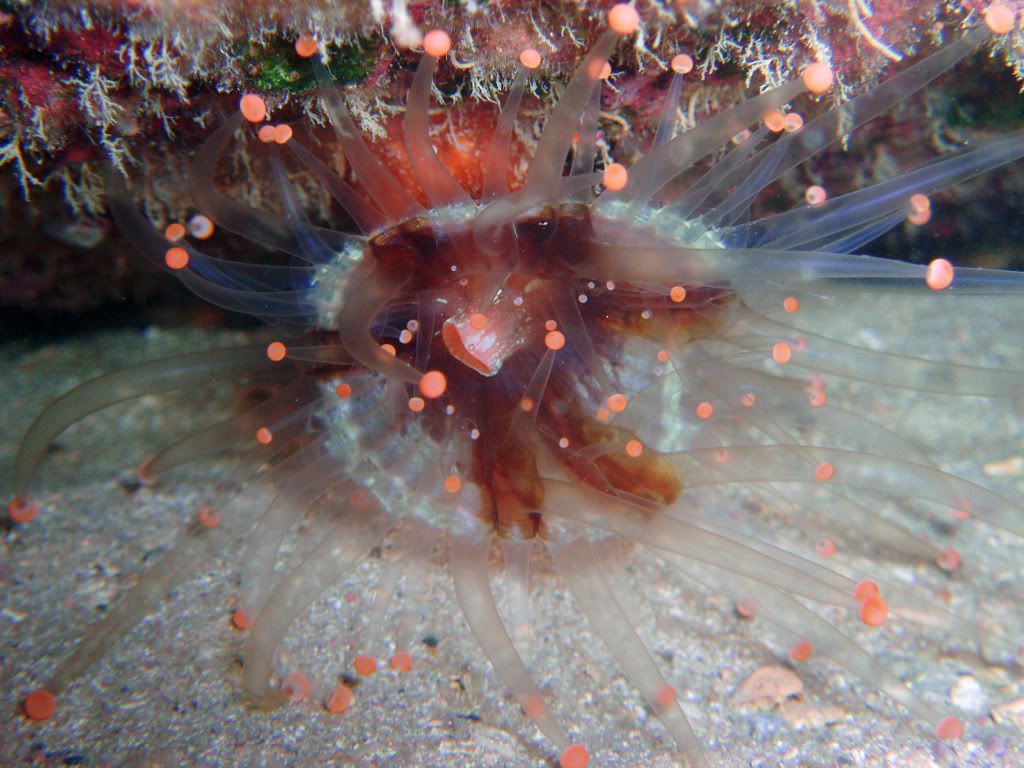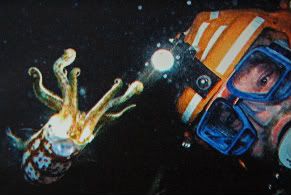In re the above comments on strobes and general obliviousness to signaling: +100
There are, however, great uses for
huge and powerful lights, even in
warm-water-pretty-fish (WWPF™
environments, most especially with
newer underwater-naturalist wannabes. But- not carried by them.
I do a lot of guiding of night dives. There is certainly a use for what I call
the "59 Chevy Headlight", in my case, the UK1200R (antique) movie light. You can fry fish with this critter, it was designed for illuminating for (actual) motion picture film cameras. It will melt if used out of the water, fact.
I have my DM ghost overhead, maybe 30' above us in "the group". He is directed to shine the light downwards, above us. This puts a very gentle glow on the reef structure, so slight that critters are really not prone to flight. I call it "streetlight", but that overstates the mild illumination.
This light is also useful for night wrecks. I send the DM ahead to illuminate the upcoming wreck by gently "painting" it as my divers approach. This has shown to alleviate the predictable stress factor of encountering a "creepy wreck" out of the blackness.
He then leapfrogs past us and gets below the outline of the wreck and illuminates it from the backside. This offers visual recognition and gives the 3D view of the wreck, again a calming thing- plus an implied invitation to "come this way" and explore further.
I also have him do this as we approach prominent Coral "heads" that loom up and often can cause irrational anxieties, most especially with large overhang structures.
In the dive briefing, I tell participants of a
special signal that means, "look for the DM". At this time, he has taken up a pre-arranged position and marks the rally point by using the super bright light as he points it at his torso and fins. (light colors and reflective accents are a plus) You can usually see this "illuminated target" from 100+ feet distant, the crowd then make their way to that pre-arranged point in the plan.
In the shallows, the
Atomic Bomb Lights are
still very useful as well. If you can coach the group to stay in a general cluster, try pointing the light at the surface and
let the reflection of light gently illuminate the bottom. This works great in 4 to 15fsw. It is not only rather pretty, but it simply will not spook critters. Different angles against the surface direct the light close-in or further out. Please try this very effective trick- it works well.
At some point in most WWPF™ dives, I will set the monster light in the sand and point it straight up, a shaft of light in the water column. Gathering everyone around, after pre-dive briefing that encourages patience and observational skills, the critters begin to appear. Many are almost clear, but only visible by their outlines highlighted against the lateral blackness of unlit areas behind. Another example of "the brighter the better".

It's all right there, if you put enough light in the water. Patience required.
These examples of using a really bright light source are excellent tools for introducing newer divers to night diving, allaying anxieties, and making it easier for them to understand their position versus natural and man-made structure. I agree, bright lights used without a plan are counter indicated for WWPF diving, but there are legitimate applications.
Never say never. Bright lights do have a use.
But... not here:

I have visited this individual at night over a hundred times. I have watched him under the chine of a wreck (at CCV), while feeding under my very dim purple LED light. When other divers eventually arrive in the area with their standard small dive lights, they may be shadowed high above me, 30' above on top of the deck of the wreck, casting no direct light on him, but he fairly quickly senses that and retracts. It doesn't take much.
Contrarily, if you slowly ease up the wattage on an Octopus, it will begin to use your light to enhance it's tactile probing to include his normal daylight abilities- eyesight. Increasing power slowly is an interesting experiment- as long as your dive buddies are in on the program. You can
change the light output of any light by using various finger spreads over the output beam, it's called "shuttering".
Same with Squid. If you illuminate them, they might not like that. If you shine the light on your extended hand, you might have a new playmate. I have slowly coaxed them towards my mask faceplate by squaring the glass directly at the Squid, and then slowly adding more light to the underside of the Squid. He sees himself in your carefully positioned reflective mask glass, and now he's sure he has a new best friend. Very commonly, you can entice them to touch their reflection in your mask faceplate. At this point they are universally oblivious to the quantity of light.
On guided night dives I often carry 5 to 7 different light sources (or my DM has them). Everything from Red Laser Pointers (good for daylight, too), tiny small output flashlights, Cyclops BlackWater, basic small Light & Motion rechargeables, the UK1200R, a converted flashlight case to house a cheap-o
UV-LED, all that kind of ditchable weight accessories. (one prominent dive expert looked at me and said I looked like a Japanese Astronaut. I'll take that as a compliment?)

So, maybe light,
and sometimes a lot of it- can be your best tool, even for WWPF™.
---------- Post added October 13th, 2014 at 03:49 PM ----------
Check out the first minute and a half of this video. I asked these guys later if they saw my light. They said yeah ... but they were busy looking for a shark .
The 00:59 mark was telling. Though- I've never seen a Shark in a junk yard before.
All 7 minutes of your encounter were captivating... As was your controlled breathing rate!







